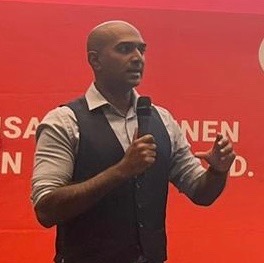
Ashant Chalasani
Founder PowerOn™ Software.
How long have you been working with the OCA and what do you do here?
Obviously, I have known OCA for the whole time we did Odoo implementations, since about 6-7 years ago. But it was a relatively passive involvement for the most part. We helped ourselves with modules every once in a while, mostly selected by our developers on a need basis, and not particular strategic alignment.
But this changed with PowerOn™ when we started to ask profound questions about how we could contribute, as well as benefit from the OCA as a technical, business, as well as a legal platform for evolving PowerOn™.
You’ve created a solution based on Odoo Community and OCA modules for photovoltaic and solar installers.
Could you explain what problems you needed to solve for these particular businesses?
ERP issues for this industry are similar to the ones that we face in other industries. There are however a few technical requirements we addressed, for example,
the Rooftop Performance Calculator utilizes satellite data to provide an estimation of the power output of the roof, as well as the investment needed to cover it with solar panels, or
the Flashlist Processor, which is used for large deliveries of solar panels, or
the CRM module’s field extensions that are relevant for a sales person in this niche during the acquisition phase of the customer relationship.
and so on and so forth
Probably the most interesting learning we had in the last one year we’ve been building and marketing for PowerOn is that the use cases across all potential customers we were talking to were uniform for the most part. So we had the opportunity to standardize not only the technical features but also the pre-sales communication, the implementation process, even documentation, based on those industry wide use-cases. This made our job easier in various parts of the custom journey, starting the first phone call way up to the go live of the ERP, and beyond into the support phase.
And why did you work for this specific sector?
Personally my main inspiration in addressing this market was to contribute to the planet’s netzero goals by 2050.
In one moment of introspection, we asked ourselves in the team: We could build ERP for every company in the phonebook, or focus on enabling companies that are contributing to resolve climate challenges, with digitalisation solutions.
We did some market research and found that the PV sector is relatively under-digitalised, especially with an all unifying ERP.

Why did you choose to work with Odoo Community Edition ?
That was one of the main strategic questions early on. Fundamentally, a) we wanted to build a SaaS product and b) we wanted to leverage the open source nature of Odoo ERP (alongside our technical skills, expertise, and people capacity).
We considered building our product around Odoo Enterprise Edition, but two specific reasons pulled us back from that approach.
The price dependency on Odoo which is driven by the S.A.’s own exponential growth strategy. We have seen in the last years that every 2 to 3 years there have been pricing modifications, which partners have to, at least in part, defend in the front lines towards customers.
Secondly, the customer ownership question: Odoo wishes to own the customer by directly billing them. So we would have had a pretty confusing relationship with PowerOn™ customers if we tried to explain to them that there is this enterprise license, and on top of that our own license.
So in the interest of the stability and clarity of our own offering, we decided to base PowerOn™ on the Community Edition.
What OCA modules did you use and what were the advantages of using such modules?
At the current time, we are using the Maintenance module, and a few other smaller ones. But we see that there is a lot more potential in the product roadmap ahead.
Which custom modules did you build on top of Odoo Community and OCA modules? Do you plan to propose them to the OCA in the future? If not, why?
There are a good 15 to 20 modules that we developed, some small and some not so small. For example, the rooftop calculator, Flashlist processor, a document scanner for scanning incoming invoices and order documents – to name a few.
We are open to proposing the modules to OCA, while considering competitive aspects, licensing, and collaboration benefits. To be honest, we haven’t understood all these aspects in their entirety as of now. That's why we are seeking out conversations within the community to deep dive into these issues, and at the same time, share our experiences in this product building journey.
Which version do you work with? What’s your migration strategy for the future?
Currently, the product is on version 15, and we plan to upgrade it to 17 shortly. We do not plan to upgrade customers across versions at this time. At some point in future we hope to develop a standard upgrade-solution which can upgrade all customers to new versions in as automated a process as possible.
If other Odoo integrators would like to propose a similar solution to photovoltaic and solar installers in their region, what can they expect from you?
I believe there is a huge opportunity to address niche markets with the Odoo ERP-framework and existing partners are well positioned to capitalize on it.
Having said that, I hope that we can partner with other companies interested in providing such a solution in their respective markets. Obviously, the competitive dynamics kick in. We are focused on the DACH market, and will be busy here for the next few years. In other markets, a collaboration makes total sense!
How do you imagine working together with other OCA/Odoo partners?
Fundamentally we would like our partners to provide local services to customers in, let’s say, a 50-100 km radius. The photovoltaic business is very regional. We believe customers appreciate local support. With partners providing that, we are relieved to focus on product-development of a truly remarkable solution.
So next to gaining more and more partners, our primary goal would be to provide them with all the training and resources, so that they can delight PowerOn™ customers in their respective regions.
We designed a formal partnership program, with the first partners already responding favorably.
All partner benefits are outlined at https://poweron.software/partner.
Contact:
Ashant Chalasani
ach@poweron.software
+49-711-7947-2394